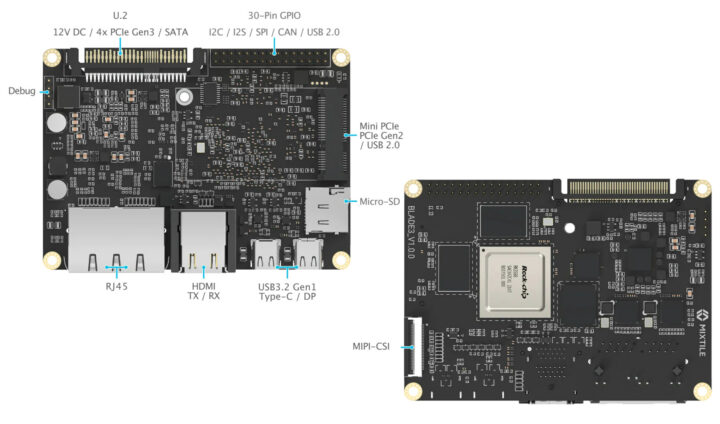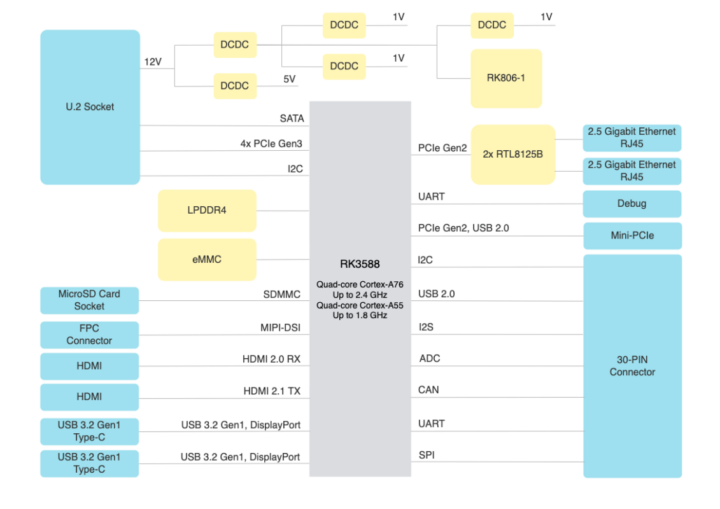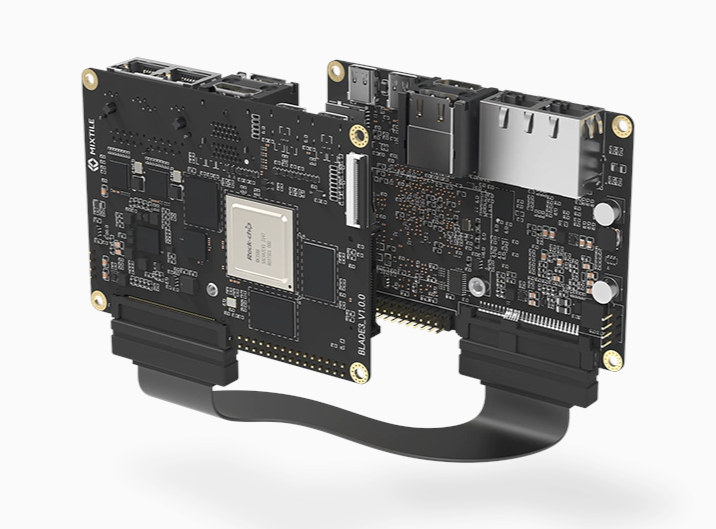The Rockchip RK3588 hype continues with the Mixtile Blade 3, a new Pico-ITX board powered by the Cortex A76/A55 processor, coupled with up to 32GB RAM, up to 256GB storage, and designed for server applications with two 2.5GbE interfaces.
The single board computer also comes with HDMI 2.1 output, HDMI 2.0 input, USB 3.2 Gen 1 USB Type-C ports, a mini PCIe Gen 2 for expansion, and a PCIe Gen 3 x4 connector to connect two Mixtile Blade 3 boards together for high-performance computing.
Mixtile Blade 3 specifications:
- SoC – Rockchip RK3588 octa-core processor with four Arm Cortex-A76 cores @ up to 2.4 GHz, four Arm Cortex-A55 cores, ArmMali-G610 MP4 quad-core GPU with support for OpenGL ES3.2, OpenCL 2.2, Vulkan1.1, 6 TOPS NPU, 48MP ISP, 8Kp60 video decoding, 8Kp30 video encoding
- System Memory – Up to 32GB LPDDR4 memory
- Storage – Up to 256GB eMMC flash, MicroSD 3.0 card socket, SATA 3.0 via U.2 edge connector,
- Video interfaces
- HDMI 2.1 out 8Kp60
- HDMI 2.0 in 4Kp60
- 4-lane MIPI DSI
- DisplayPort 1.4a via USB-C ports
- Networking – Dual 2.5 Gigabit Ethernet RJ45 ports with link aggregation
- USB – 2x USB 3.2 Gen1 Type-C ports with DisplayPort 1.4a
- Expansion
- U.2 edge connector with 4-lane PCIe Gen3, SATA 3.0
- Mini PCIe socket with PCIe Gen2.1 and USB 2.0
- 30-pin GPIO header with GPIOs, I2C, USB 2.0, TTL UART, SPI, I2S, ADC
- Power Supply – 12V via U.2 connector
- Dimensions – 100 x 72 mm (2.5-inch Pico-ITX form factor)
- Temperature Range – 0 to +80°C
The company plans to provide Android 12 with a Linux container, and although the board is quite versatile, when asked whether the board was designed for server applications, Mixtile confirmed it indeed was. When further asked why not just run Linux, I was told that driver support for Android 12 is better, so they just run a Linux container inside Android to make software development easier…
Some of the use cases include simple clusters and high-density servers with up to 75 Blade 3 boards in a standard 2U 19-inch chassis that would get 600 cores and the equivalent of 630 GHz of computing power in 1500 watts power envelop.
Pricing is quite competitive, especially considering Firefly is asking for close to $500 for their RK3588 mini-ITX motherboard, with Mixtile Blade 3 selling for $160 with 4GB RAM and 32GB storage, $195 in 8GB/64GB configuration, and $259 in 16GB/128GB configuration. Those are still pre-order, but the Mixtile shop reads “preorders will end by March 31 and ship in April.” That looks like an optimistic schedule to me, and when I asked for photos of the board, I was told that the real samples are not available yet, they’ve completed the schematics, and are currently working on the PCB layout. I had a good laugh, and I can tell you the board is almost certainly not shipping in April! Having said that, it’s most probably not vaporware, as Mixtile has been around for several years, and we wrote about their boards as far back as 2014.

Jean-Luc started CNX Software in 2010 as a part-time endeavor, before quitting his job as a software engineering manager, and starting to write daily news, and reviews full time later in 2011.
Support CNX Software! Donate via cryptocurrencies, become a Patron on Patreon, or purchase goods on Amazon or Aliexpress








Strange, if still in PCB layout stack, how come there is stock photo???
This is what I was told:
So either the PCB layout is complete, or they are in the later stage of the design in order to create a render.
I am glad to inform you that even the Ikea catalog is at 90% 3d rendering
Just wonder whether this will get official linux support, with its computing power this looks like a great platform for CPE router, iKVM ( maybe porting PiKVM to this board? )
“driver support for Android 12 is better, so they just run a Linux container inside Android to make software development easier…” … weird indeed.
I too am worried that they keep this Android excuse for not making any effort on Linux. The board looks interesting and at a reasonable price, the U2 connector might be convenient or might be problematic depending on the use cases, but lack of native Linux support will cancel any other benefit. And no, running linux inside an android container is not an option, that board is not a smartphone and it has everything to make a server board. Linux is not that much a matter of userland, it’s first and foremost a kernel (otherwise debian kfreebsd would be called linux). I’m afraid that we might already be witnessing the usual Rockchip’s “commitment” to opensource, waiting for their customers to do all the upstream work as usual.
To be fair – Android have linux kernel and anyone who built kernel from source saw Android drivers here and there. Userland is much different…
Android can barely be called linux nowadays. Usually the total size of the patches applied to BSP kernels is larger than the kernel itself. You have no control over the build options since the changes are so ugly that only one precise set of options manages to build and the rest is untested at best, otherwise broken. The choice of modules usually doesn’t match what you’d need outside of a smartphone or tablet. And some syscalls considered deprecated or irrelevant there are often not even enabled, making it impossible to run certain legacy applications. I’ve used linux rootfs running under Android kernels. No more!
The Rockchip BSP for RK3588 is based on a 5.10.66 kernel which looked promising. But Willy looked deeper inside few months ago just to discover that this kernel is a forward ported mess from IIRC 2.6 on.
For this reason alone you don’t want to run anything ‘serious’ based on this kernel, be it a Linux userland combined with this kernel or a container inside Android.
Yeah it’s like a commitment to not even try.
the title is “for server applications”. Does the product manager of the Mixtile Blade 3 think Android is an OS for server applications?
I looks like a hardware introduction without a market plan.
designed mostly for server side integration, but not only (guessing), why ‘MIPI DSI’ (and maybe HDMI out without HDMI in for special purposes) would be some kind of strange inside server racks for all of a whole cluster of computing modules and performance of RK3588 seems to allow Linux container on Android (how else to use high performance instead, and satisfy all needs?)?
Demand (depending on prices then) will shape that market (since RK3588 seems being/getting a favourite SoC for embedded computing designers)?
> the title is “for server applications”
The title of a blog post as the result of an answered question (language barriers included). Think about where those Android Rockchip SoCs usually end up: in TV boxes, Chromebooks or tablets. This thing is obviously none of them.
‘Server applications’ are stuff like smart surveillance and all this crap (where this SoC can shine due to video, AI and I/O capabilities).
[ ‘smart surveillance and all this crap’ wrt to developers mindset for to negate exaggerated surveillance ]
Can I ask at this price point why would you select this over a similar price x86 board?
I guess the *only* reason is if you’re trying to build your own RK3588 board and need a competing one to start from.
It will be nice to have version without eMMC and we can just boot up from network. That is more then enough for blade server
Thank you @m][sko for your thought of Blade 3. We have another model that uses SPI Flash instead of eMMC but is not on the preorder product list. That model is only available for batch purchase now.
Do you provide overview with benchmark numbers (like sbc-bench from Linux container)? (thx)
Thank you for the suggestion. We’ll add the benchmark part to the preparing documents.
What’s the meaning of that?
I thought it would be great to add benchmark data to the product’s detailed web page and user documentation. We will do it. I’ve started thinking about which single board computers would be suitable reference objects.
This is a good initiative. Some of us here tried to make things change several years ago regarding fake numbers advertised by unscrupulous vendors, hoping that one day some honest ones would probably publish their numbers upfront themselves because they wouldn’t fear these numbers being rechecked.
Odroid N2+ and the obligatory Pi 4b would be two you can add to the comparison.
Cheap U.2 (SFF-8639) to PCIe/M.2 adapters (cards) might start around $15 for compatibility to consumer hardware storage sector (Some add SFF-8643 also, beware of PCIe/NVMe and SAS conversions on (U.3), because of electrical differences for data lane’s impedance from 85 to 100Ohms.)
Servers would be worth a 32GB memory version.
Seems like a nice and tidy solution.
So, it is around 20K for 2U and you get 1.6Tb RAM and 9.6Tb storage and 300+300 cores, right? Isn’t it a bit of too optimistic pricing nowadays?
> it is around 20K for 2U and you get 1.6Tb RAM and 9.6Tb storage and 300+300 cores, right?
If your numbers are based on 75 times ‘$259 in 16GB/128GB’ then nope. The RAM capacity sum is 1.2TB and the $259 is a marketing/pre-order number (370 bucks list price). The 75 ‘blades’ can’t be just thrown into an enclosure but there need to be PCIe interconnects, power distribution and either the 150 2.5GbE ports are wasted and/or some additional rack units + additional costs are needed for Ethernet connectivity.
1.2TB obviously, my bad. Yes, I oversimplified a bit, but still, even in 30-35K area for 370 per blade it is quite cheap. As you mentioned above, for video apps like surveillance, CV and even transcoding it’s well worth it.
> Power Supply – 12V via DC jack
Doesn’t it look like DC-IN is through the U.2 socket?
Ah yes, but then the last photo is non-sensical since the boards could not get power… The cable must be a bit different.
Given the blade concept I would believe this thing will always sit in an U.2 socket in some sort of a carrier board or backplane. The most primitive variant maybe hosting one blade, providing four M.2 slots for AI accelerators and SATA, more sophisticated ones taking more than one blade allowing for PCIe interconnects.
At least nothing for the typical RK3588 fanboy who after years of announcements and continous delays still dreams of a powerful yet affordable Linux desktop platform 🙂
@tkaiser, we will send you a ROCK 5B a few days later.
Tom, you should be careful going into that direction, especially here, otherwise many of us will quickly express huge interest to get ours as well 🙂
@Willy: True that!
And best luck for ROCK 5B. Hope the kernel and everything will be ironing out nicely several months after launching.
I thought you had yours on pre-order 😀
No because it’s not a pre-order at all, you pre-order a reduction to use later. To me that’s pointless. I’d rather pre-pay the whole price upfront and wait for the thing to arrive than pre-pay for a future reduction. Thus I’ll have to wait and see when the product is ready.
Any information about the base board where we can put multiple Mixtile Blade 3 or how we can connect multiple Mixtile Blade 3 together.
There are two options:
Any link to backplane boards ? I am not aware of any U.2 backplane board 🙂
We will publish details about cables and backplanes on our website soon. I’ll post a link here when the info is ready.
@m][sko
Quick survey, how many are in your mind when you say “multiple Blade 3”? Don’t you like the idea of daisy chain cable?
Martin, your site mentions that the U.2 link allows to daisy chain at up to 20 Gbps. But what’s not clear to me at all is that the diagram above only shows SATA, PCIe, I2C and power supply on this connector. Thus how do machines communicate using a passive cable, and using what protocol ? Or maybe you’re using active cables with something like an ethernet chip on PCIe ?
I think that this ability to form clusters from your boards might be a strong differentiator for some users but it’s not clear at all on the site nor above, where one would think that it’s essentially used to share the power supply for mutual redundancy. Thanks for any extra detail.
> your site mentions that the U.2 link allows to daisy chain at up to 20 Gbps
You’re talking about their claim ‘when 4 pieces of Blade 3 work together, the network speed will boost up to 20 Gbps’? I guess that’s just marketing ‘math’. Each Blade 3 features two 2.5GbE ports so 4 x 2 x 2.5 = 20 Gbps.
Maybe, but then I still don’t understand what the daisy chaining is made for in this case. You cannot simply connect PCIe in parallel like this. Or is the PCIe controller reversible to become a slave in which case there could be one slave controller chained to the next master and circling back like this ? I find all this very confusing but at the same time I’m pretty sure they didn’t make special cables just to share the power lanes. This is what I do not understand.
The daisy chain cable is mainly a PCIe cable to connect several Blade 3 via the PCIe channels and distribute power to these boards. Every Blade 3 works on both “master” and “slave” modes when connected to a special daisy chain cable. I know this isn’t explained clearly, I will make some diagrams to describe this mechanism in our documents.
OK thank you. I’m indeed curious to see how that works and how that’s supported by operating systems.
The $229-369 asking price seems way too much, given the rock 5b now sells for $129-189 ($149-$259 with as much emmc) or the r6s for $119. The cluster over PCIe solution is slick, but is inherently “just” software, with a simple m2 adapter the rock 5b can be clustered the same way.
so this leaves us with (compared to the rock 5b):
– exposes one more each : sata/pcie2x1 & 2.5GbE & USBC/DP
– exposes one less trrs & ~10 GPIO less (not hat compatible)
– non-removable emmc, no PoE, no rtc-battery
wish they made a version with removable emmc priced $179/199/249 (wo/ emmc). that make the board much more attractive (just 41 backers on crowd supply…)!
oh and i think instead of u.2, m.2 fins and using the space savings for a full rpi compatible 40pin gpio would have been much better idea!